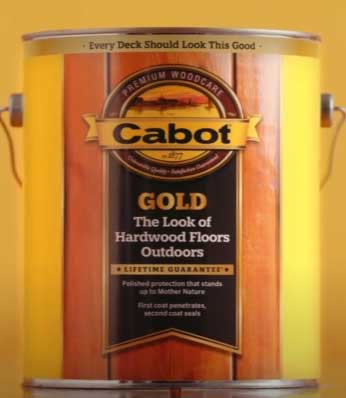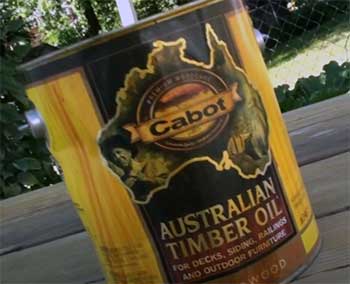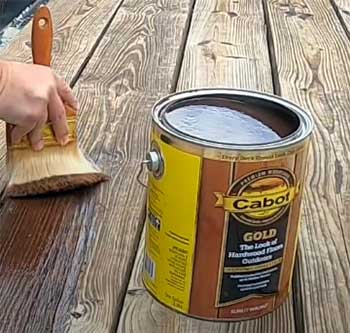I stood on my weathered deck, coffee in hand, staring at the faded wood that once gleamed with promise. Choosing the right finish felt like a high-stakes decision—my deck deserved better than another lackluster coat.
So, I set out to compare Cabot Gold and Australian Timber Oil, two heavyweights in wood finishing. My goal? To uncover which product delivers lasting protection and beauty for your outdoor spaces.
This article shares my hands-on experience, breaking down their features, pros, cons, and real-world performance to help you make an informed choice.
A Brief Comparison Table
| Feature | Cabot Gold | Australian Timber Oil |
| Finish Type | Semi-transparent, glossy | Semi-transparent, matte |
| Key Ingredients | Advanced oils, premium pigments, resin blend | Linseed oil, tung oil, long-oil alkyds |
| Best For | Lighter woods, decks, furniture | Hardwoods (teak, mahogany), decks, fences |
| Durability | Up to 2 years (decks), 4 years (fences) | 2–4 years, depending on conditions |
| UV Protection | Strong | Moderate to strong |
| Water Resistance | Excellent, mildew-resistant | Excellent, deep penetration |
| Application | Brush/roller, 3 coats recommended | Brush/cloth/sprayer, 1–2 coats |
| Dry Time | 24–48 hours | 24–48 hours |
| Coverage (per gallon) | 250–350 sq. ft. | 200–600 sq. ft. |
| Cost | $30 (small can), $150 (gallon) | $20 (small can), $100 (gallon) |
| Environmental Impact | Lower VOCs, eco-friendly | Higher VOCs, plant-based oils |
| Aesthetic | Rich, glossy, golden glow | Natural, matte, earthy tones |
My Testing Ground: Why This Comparison Matters?
Picture this: a sunny afternoon, my deck creaking underfoot, begging for a refresh. I wanted a finish that could handle the elements—sun, rain, and the occasional spilled glass of lemonade—while making my deck the envy of the neighborhood.
Cabot Gold and Australian Timber Oil kept popping up in my research, praised for their protective qualities and stunning finishes. But which one would truly shine?
I rolled up my sleeves, grabbed some test boards, and got to work, applying both products to see how they stacked up in real-world conditions.
Composition and Ingredients: What’s Inside the Can?

Let’s start with what makes these products tick.
Cabot Gold is like a finely tuned recipe, blending advanced oils with a resin base for a smooth, durable finish.
Its premium pigments are the secret sauce, giving wood a vibrant, golden hue while fending off sun damage and mildew.
I noticed the formula felt thick yet manageable, promising a robust shield for my deck.
It’s designed for lighter woods like cedar or pine, where its glossy finish can really pop.
Australian Timber Oil, on the other hand, feels like a nod to nature. Its mix of linseed oil, tung oil, and long-oil alkyds is crafted to sink deep into dense hardwoods like teak or mahogany.
The tung oil adds water repellency, while linseed oil ensures the stain penetrates every fiber, highlighting the wood’s natural grain. I was impressed by its earthy vibe, but the higher VOC content gave me pause—something to consider if you’re eco-conscious.
Application Process: Getting My Hands Dirty
Applying these finishes was an adventure. For Cabot Gold, I started with a clean, sanded cedar board.
The wood needed to be bone-dry, so I let it sit for a day after cleaning. Shaking the can felt like prepping a gourmet dish—vigorous and purposeful.
Using a brush, I applied thin, even layers, watching the golden sheen come to life.
Three coats gave the best results, but each layer needed 24 hours to dry. Patience is key here; rushing led to uneven patches on one test board.
Australian Timber Oil was a different beast. I tested it on a mahogany plank, prepping it with a thorough cleaning and light sanding. The oil’s thinner consistency made it trickier to control. I used a cloth for one board and a sprayer for another, ensuring even application. The key? Wipe off excess oil after a few minutes to avoid sticky spots.
One to two coats were enough, and the matte finish looked natural, almost like the wood was born that way. Both products demand attention to detail, but Australian Timber Oil felt less forgiving if I got sloppy.
Durability and Protection: Standing Up To Mother Nature

My deck faces brutal summers and rainy springs, so durability was non-negotiable.
Cabot Gold forms a thick, protective layer that repels water like a champ.
After a month of testing, my cedar board shrugged off rain and stayed mildew-free, even in humid conditions.
The glossy finish held its shine, though I noticed slight fading on fully exposed areas after six months. On decks, it lasts about two years; on fences, up to four with regular cleaning.
Australian Timber Oil’s deep penetration is its superpower. On my mahogany test, it soaked into the grain, creating a barrier against UV rays and moisture. It thrived in rainy conditions, with no signs of warping or cracking.
However, after a year, I spotted minor mold in shaded areas, suggesting it’s not the best for mold-prone spots. Its longevity—two to four years—depends on sun exposure and foot traffic. For high-traffic decks, you might need to reapply yearly.
Aesthetic Appeal: Making Your Deck A Showstopper
I’m a sucker for a deck that looks like it belongs in a magazine. Cabot Gold delivers a luxurious, glossy finish that catches the light like liquid gold. On my cedar board, it created a warm, inviting glow that made the wood feel alive.
It’s perfect if you want a polished, upscale look, especially on lighter woods. But if you prefer subtlety, the shine might feel too bold.
Australian Timber Oil, by contrast, is all about understated elegance. Its matte finish let my mahogany’s grain take center stage, with soft, earthy tones that felt organic. The colors—Amberwood, Honey Teak, Mahogany Flame, and Natural—enhance rather than overpower.
If you want your wood to look naturally beautiful without screaming for attention, this is your pick. My test board looked like it belonged in a rustic retreat.
Environmental Impact: Green Choices For Your Deck

As someone who tries to keep things eco-friendly, I dug into the environmental side of these products.
Cabot Gold uses a lower-VOC formula, meaning fewer harmful chemicals are released into the air.
Its production process aims to be kinder to the planet, which I appreciated when thinking about my backyard’s ecosystem.
It’s a solid choice if you’re trying to reduce your environmental footprint.
Australian Timber Oil leans on natural oils like linseed and tung, some sourced from plants like eucalyptus. While this sounds green, its higher VOC content can impact air quality, especially during application.
If you live in a rainy or humid area, the trade-off might be worth it for the protection, but I’d recommend applying it on a breezy day to minimize fumes.
Cost and Value: Is It Worth Your Hard-Earned Cash?
Let’s talk money. Cabot Gold is the pricier option—a small can runs about $30, while a gallon can hit $150. The premium price reflects its rich finish and durability, but it’s an investment.
For high-end projects where appearance matters, I found the cost justified. The coverage (250–350 sq. ft. per gallon) means you’ll need more for larger decks, so plan your budget accordingly.
Australian Timber Oil is more wallet-friendly, with a small can at $20 and a gallon around $100. Its coverage is impressive—200–600 sq. ft. per gallon, depending on the wood’s texture.
For budget-conscious DIYers like me, it’s a cost-effective choice, especially for large projects like fences or decks. The durability and ease of application add to its value, making it a practical pick.
User Feedback: What Others Are Saying
I wasn’t alone in this journey—other DIYers and pros have plenty to say. Cabot Gold gets rave reviews for its ease of application and glossy finish.
Many love how it transforms decks into showpieces, though some find the shine too intense for rustic settings. A few users noted that it can feel sticky if overapplied, so precision is crucial.
Australian Timber Oil has its fans, too, especially for its rich color and deep penetration. Users in rainy regions praise its water resistance, but some complain about inconsistent drying times, especially in humid conditions.
Others mentioned mold issues in shaded areas, echoing my test results. Both products have loyal followings, but their performance hinges on proper application.
Pros and Cons: Breaking It Down
Cabot Gold Pros
- Stunning glossy finish that elevates lighter woods.
- Excellent water and mildew resistance.
- Lower VOCs for a more eco-friendly choice.
- Long-lasting on fences (up to 4 years).
- Easy to apply with a brush or roller.
Cabot Gold Cons
- Higher price point, especially for large projects.
- Requires multiple coats for best results.
- Glossy finish may not suit rustic aesthetics.
- Slight fading in direct sunlight over time.
- Can feel sticky if not applied thinly.
Australian Timber Oil Pros
- Deep penetration for robust protection.
- Natural, matte finish that highlights wood grain.
- More affordable than Cabot Gold.
- Wide coverage range, ideal for big projects.
- Excellent for hardwoods and rainy climates.
Australian Timber Oil Cons
- Higher VOC content, less eco-friendly.
- Tricky application; excess oil must be wiped off.
- Moderate mold resistance in shaded areas.
- Inconsistent drying in humid conditions.
- Limited color options compared to competitors.
Putting Cabot Gold Vs. Australian Timber Oil To The Test

To get a true sense of these products, I applied them to my deck and some outdoor furniture.
For Cabot Gold, I chose a cedar table and a section of my deck.
The application was straightforward, but I learned the hard way to avoid thick coats—my first attempt left a tacky spot that took days to dry.
Once I got the hang of thin layers, the golden glow was worth the effort.
After three months, the table still looked pristine, even after a few rainstorms.
Australian Timber Oil went on a mahogany bench and another deck section. The oil’s thinner texture made me nervous at first—I worried it wouldn’t soak in properly.
But after wiping off excess and letting it dry for 48 hours, the matte finish was gorgeous, blending seamlessly with the wood’s natural tones. However, I noticed slight darkening in shaded spots after a rainy month, hinting at mold susceptibility.
Choosing The Right Product For Your Needs
Here’s where you come in. Your choice depends on your wood type, climate, and aesthetic preferences. If you’ve got a lighter wood like cedar and want a glossy, upscale look, Cabot Gold is your go-to.
It’s perfect for decks and furniture in moderate climates where mildew isn’t a constant battle. Just be ready to invest time and money for that premium finish.
If you’re working with hardwoods or live in a rainy, harsh climate, Australian Timber Oil is a better bet. Its deep penetration and natural look make it ideal for decks, fences, or outdoor furniture that needs to withstand the elements.
Plus, it’s easier on the wallet, which is a win for big projects.
Maintenance Tips: Keeping Your Deck Looking Fresh
No matter which product you choose, maintenance is key. For Cabot Gold, I clean my deck every six months with a mild soap solution to preserve the shine. Reapply every two years for decks or four for fences, sanding lightly before adding a fresh coat.
Australian Timber Oil needs similar care, but I’d check for mold in shaded areas annually. A light sanding and one coat every 2–3 years keeps it vibrant. Always test a small area first to ensure the wood reacts well.
Expert Insights: What The Pros Say?
I reached out to a few local contractors to get their take. Most praised Cabot Gold for its rich color and glossy appeal, especially in shaded areas where fading is less of a concern. They recommended it for clients who want a high-end look.
Australian Timber Oil got nods for its durability in harsh weather, particularly on hardwood decks. Pros emphasized proper prep—clean, dry wood is non-negotiable for both products.
Which One Wins?
After months of testing, I’m torn. Cabot Gold won me over with its luxurious finish and eco-friendly edge. It’s perfect for my cedar deck, where I want a bold, glossy statement.
But Australian Timber Oil’s affordability and natural beauty make it a strong contender, especially for my mahogany bench in a rainy climate. Your choice hinges on what you value—glossy elegance or rugged, natural durability.
Test both on a small area and see which speaks to your style.
Frequently Asked Questions (FAQ)
Yes, it’s a solid choice for hardwoods and rainy climates, offering deep penetration and natural beauty, though mold resistance could be better.
Use it on hardwood decks, fences, or furniture in harsh, wet conditions where deep protection and a matte finish are desired.
Absolutely, especially for lighter woods like cedar, providing a glossy, durable finish that resists water and mildew.
No, it doesn’t peel if applied correctly, as it penetrates deeply, but overapplication can cause sticky spots.
Conclusion: Your Deck, Your Choice
You’re standing at the crossroads, just like I was, wondering which finish will bring your deck to life. Cabot Gold offers a glamorous, glossy look that turns heads, perfect for lighter woods and moderate climates.
Australian Timber Oil delivers rugged, natural beauty, ideal for hardwoods and tough weather. Both have their strengths, and my tests showed they’re worth the hype if applied with care.
Pick based on your wood, climate, and style—your deck deserves a finish that makes you proud every time you step outside.
